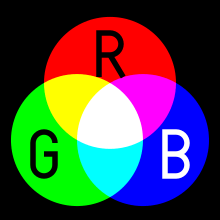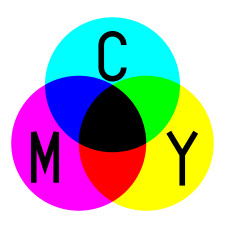List of color spaces and their uses
This is a list of color spaces, grouped by the color model that is used for part of their specification.
Models
There are five major color models: CIE, RGB, YUV, HSL/HSV, and CMYK. These models and their variants are employed in parts of the color spaces listed below.


CIE
CIE 1931 XYZ
CIE 1931 XYZ was the first attempt to produce a color space based on measurements of human color perception and the basis for almost all other color spaces.
CIELUV
A modification of "CIE 1931 XYZ" to display color differences more conveniently. The CIELUV space is especially useful for additive mixtures of lights, due to its linear addition properties.[1]
CIELAB
CIELAB produces a color space that is more perceptually linear than other color spaces. Perceptually linear means that a change of the same amount in a color value should produce a change of about the same visual importance. CIELAB has almost entirely replaced an alternative related Lab color space called “Hunter Lab”. This space is commonly used for surface colors, but not for mixtures of (transmitted) light.[1]
CIEUVW
Measurements over a larger field of view than the "CIE 1931 XYZ" color space which produces slightly different results.
RGB Chromacity Primaries
RGB (Red, Green, Blue) describes the chromacity component of a given color, when excluding luminance. RGB itself is not a color space, it is a color model. There are many different color spaces that employ this color model to describe their chromacities because the R/G/B chromacities are one facet for reproducing color in CRT & LED displays.
sRGB
The sRGB color space (standard Red Green Blue) was created jointly by Hewlett-Packard and Microsoft for use on the Internet. It has been endorsed by the W3C, Exif, Intel, Pantone, Corel, and many other industry players. It is also well accepted by open-source software such as the GIMP, and is used in proprietary and open graphics file formats such as SVG.
sRGB is intended as a common color space for the creation of images for viewing on the Internet and World Wide Web (WWW), the resultant color space chosen using a gamma of 2.2, the average response to linear voltage levels of CRT displays at that time.
Adobe RGB
The Adobe RGB color space was developed by Adobe Systems in 1998. It was designed to encompass most of the colors achievable on CMYK color printers, but by using RGB primary chromacities on a device such as the computer display. The Adobe RGB color space encompasses roughly 50% of the visible colors specified by the Lab color space, improving upon the gamut of the sRGB color space primarily in cyan-greens.
Adobe Wide Gamut RGB
The Adobe Wide Gamut RGB color space was developed by Adobe Systems as an alternative to the standard sRGB color space. It is able to store a wider range of color values than sRGB. The Wide Gamut color space is an expanded version of the Adobe RGB color space, developed in 1998. As a comparison, the Adobe Wide Gamut RGB color space encompasses 77.6% of the visible colors specified by the Lab color space, whilst the standard Adobe RGB color space covers just 50.6%.
One of the downsides to this color space is that approximately 8% of the colors representable are imaginary colors that do not exist and are not representable in any medium.[2] This means that potential color accuracy is wasted by reserving these unnecessary colors.
Others with RGB primaries
- ProPhoto RGB color space
- scRGB
- DCI-P3, used primarily for digital movie projection
- Rec. 709
- Rec. 2020
- Academy Color Encoding System (ACES)
Cylindrical transformations
HSV and HSL
HSV and HSL are transformations of Cartesian RGB primaries (usually sRGB), and their components and colorimetry are relative to the colorspace from which they are derived. HSV (hue, saturation, value), also known as HSB (hue, saturation, brightness), is often used by artists because it is often more natural to think about a color in terms of hue and saturation than in terms of additive or subtractive color components. HSL (hue, saturation, lightness or luminance), also known as HSI (hue, saturation, intensity) or HSD (hue, saturation, darkness), is quite similar to HSV, with "lightness" replacing "brightness". The difference is that a perfectly light color in HSL is pure white; but a perfectly bright color in HSV is analogous to shining a white light on a colored object. I.e. shining a bright white light on a red object causes the object to still appear red, just brighter and more intense. Shining a dim light on a red object causes the object to appear dark and less bright.
CIELChab and CIELChuv
CIELChab and CIELChuv are cylindrical transformations of the CIELAB and CIELUV color spaces, respectively. The cylindrical coordinates C* (chroma, relative saturation) and h° (hue angle, angle of the hue in the color wheel) are specified. The CIELAB and CIELUV coordinate L* (lightness) remains unchanged.
CMYK
CMYK
CMYK is used in the printing process, because it describes what kind of inks need to be applied so the light reflected from the substrate and through the inks produces a given color. One starts with a white substrate (canvas, page, etc.), and uses ink to subtract color from white to create an image. CMYK stores ink values for cyan, magenta, yellow and black. There are many CMYK colorspaces for different sets of inks, substrates, and press characteristics (which change the dot gain or transfer function for each ink and thus change the appearance).
Commercial color spaces
- Munsell color system
- Natural Color System (NCS)
- Pantone Matching System (PMS)
- RAL
- Aerospace Material Specification - Standard 595A (Supersedes (US) Federal Standard 595C)[3]
- (US) Federal Standard 595C
- British Standard Colour (BS)
- HKS
Special-purpose color spaces
- The rg chromaticity space is used in computer vision applications, and shows the color of light (red, yellow, green, etc.), but not its intensity (dark, bright).
- LMS color space (long, medium, short), a perceptual color space based on the response functions of the cones in the retina of the eye. It is mostly used in psychophysical research.
Obsolete color spaces
Early color spaces had two components. They largely ignored blue light because the added complexity of a three-component process provided only a marginal increase in fidelity when compared to the jump from monochrome to two-component color.
- RG for early Technicolor film
- RGK for early color printing
References
- Keith McLaren; "Dyes, General Survey" in: Ullmann's Encyclopedia of Industrial Chemistry; Wiley-VCH; 15 June 2000.
- "AMS STANDARD 595A COLOR". www.ams-std-595-color.com. SAE and Harzen. Retrieved 12 July 2019.
External links
- Precise Color Communication—Konica Minolta Sensing
